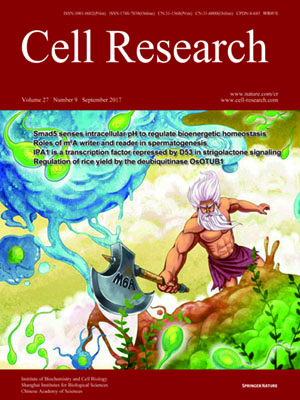
Volume 27, No 9, Sep 2017
ISSN: 1001-0602
EISSN: 1748-7838 2018
impact factor 17.848*
(Clarivate Analytics, 2019)
Volume 27 Issue 9, September 2017: 1083-1099 | Open Access
ORIGINAL ARTICLES
Smad5 acts as an intracellular pH messenger and maintains bioenergetic homeostasis
Yujiang Fang1, Zhongliang Liu1, Zhenyu Chen1, Xiangjie Xu1, Mengtao Xiao4, Yanyan Yu4, Yuanyuan Zhang1, Xiaobai Zhang3, Yanhua Du3, Cizhong Jiang3, Yuzheng Zhao5, Yiran Wang1, Beibei Fan1, Daniel Terheyden-Keighley1, Yang Liu1, Lei Shi1, Yi Hui2, Xin Zhang2, Bowen Zhang1, Hexi Feng1, Lin Ma1, Quanbin Zhang1, Guohua Jin2, Yi Yang5, Bin Xiang4, Ling Liu1,6 and Xiaoqing Zhang1,6,7
1Shanghai Tenth People's Hospital, and Neuroregeneration Key Laboratory of Shanghai Universities, Tongji University School of Medicine, Shanghai 200092, China
2Department of Anatomy and Neurobiology, the Jiangsu Key Laboratory of Neuroregeneration, Nantong University, Jiangsu 226001, China
3The School of Life Sciences and Technology, Tongji University, Shanghai 200092, China
4China Novartis Institutes for BioMedical Research, Shanghai 201203, China
5Synthetic Biology and Biotechnology Laboratory, State Key Laboratory of Bioreactor Engineering, Shanghai Collaborative Innovation Center for Biomanufacturing Technology, East China University of Science and Technology, Shanghai 200237, China
6Tongji University Advanced Institute of Translational Medicine, Shanghai 200092, China
7The Collaborative Innovation Center for Brain Science, Tongji University, Shanghai 200092, China
Correspondence: Xiaoqing Zhang, Tel: 86-21-65982435; Fax: 86-21-65985003 E-mail: xqzhang@tongji.edu.cn; Ling Liu, Tel: 86-21-65985003; Fax: 86-21-65985003 Email: lliu@tongji.edu.cn; Bin Xiang,(bin.xiang@novartis.com)
Both environmental cues and intracellular bioenergetic states profoundly affect intracellular pH (pHi). How a cell responds to pHi changes to maintain bioenergetic homeostasis remains elusive. Here we show that Smad5, a well-characterized downstream component of bone morphogenetic protein (BMP) signaling responds to pHi changes. Cold, basic or hypertonic conditions increase pHi, which in turn dissociates protons from the charged amino acid clusters within the MH1 domain of Smad5, prompting its relocation from the nucleus to the cytoplasm. On the other hand, heat, acidic or hypotonic conditions decrease pHi, blocking the nuclear export of Smad5, and thus causing its nuclear accumulation. Active nucleocytoplasmic shuttling of Smad5 induced by environmental changes and pHi fluctuation is independent of BMP signaling, carboxyl terminus phosphorylation and Smad4. In addition, ablation of Smad5 causes chronic and irreversible dysregulation of cellular bioenergetic homeostasis and disrupted normal neural developmental processes as identified in a differentiation model of human pluripotent stem cells. Importantly, these metabolic and developmental deficits in Smad5-deficient cells could be rescued only by cytoplasmic Smad5. Cytoplasmic Smad5 physically interacts with hexokinase 1 and accelerates glycolysis. Together, our findings indicate that Smad5 acts as a pHi messenger and maintains the bioenergetic homeostasis of cells by regulating cytoplasmic metabolic machinery.
10.1038/cr.2017.85
FULL TEXT | PDF
Browse 1470


